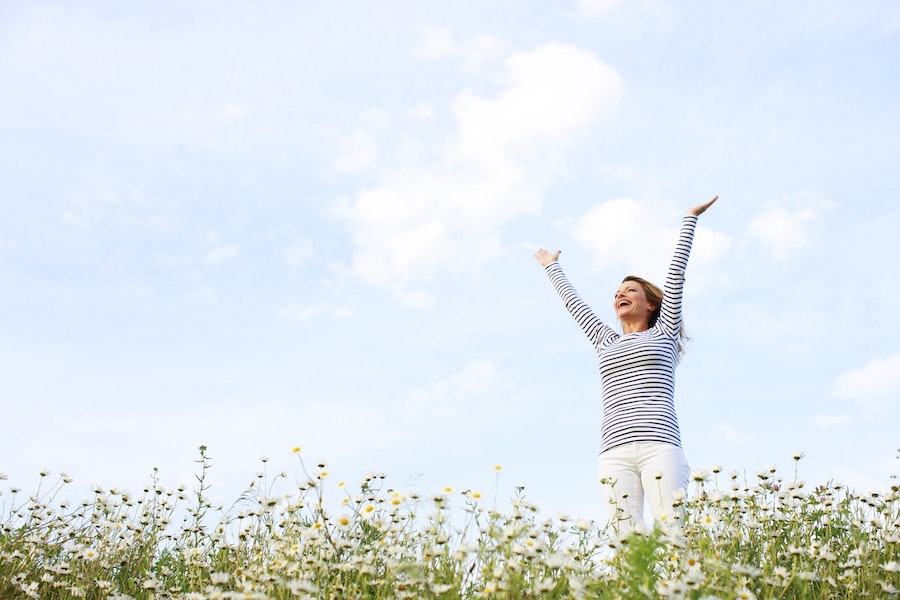6 ways to treat menopause symptoms – without taking HRT
Lots of women experience symptoms due to menopause, many of which can be very unpleasant.
Caused by fluctuating and lower levels of oestrogen as the ovaries stop producing eggs, these can include hot flushes and night sweats, sleep difficulties, musculo-skeletal problems, mood changes, uro-genital symptoms and sexual issues.
Thankfully though, there are lots of things that can help. One of the most obvious treatments for menopause are conventional hormone replacement therapies (HRT). The best thing to do is discuss your symptoms and options with your own doctor, as managing menopause can be a very personal thing.
However, for women who chose not to pursue HRT, or those unable to because of their medical history, there are other things to think about.
Women’s Health Concern (WHC), the patient arm of the British Menopause Society (BMS), says a recent survey found 95% of women would try alternative therapies before HRT, because they think they’re more natural and because they’re worried about the health risks of HRT. However, WHC warns herbal remedies which aren’t regulated by a medicine authority shouldn’t be considered safer [than HRT], as there’s varied effectiveness and potency, and there may be significant side-effects. The BMS also says compounded bioidentical therapies aren’t recommended as they aren’t licensed or regulated, and there’s a lack of evidence to support safe use.
Haitham Hamoda, chair of the British Menopause Society, says: “Hormone replacement therapy is the most commonly-prescribed treatment for menopausal symptoms, but this form of therapy is not suitable for some women, such as those with a history of breast cancer. A number of lifestyle changes, non-prescribed treatments and prescribed treatments are available to women experiencing various symptoms of the menopause. ”
As well as lifestyle changes, cognitive behavioural therapy (CBT) and vaginal moisturisers and lubricants, he says non-prescribed treatments including herbal medicines, alternative therapy and complementary therapy, such as aromatherapy, acupressure, or acupuncture may help, but stresses the effects of these therapies are not well known.
“If symptoms are stopping women from carrying on with their normal life, they should talk to their GP or call NHS 111,” he adds.
It is #worldmenopauseday
Here is a great poster from @pausitivity to raise awareness of the symptoms as sometimes peri menopause of #menopause may not be considered as a cause. pic.twitter.com/taQC4KFOfY
— Menopause GP (@MenopauseGp) October 18, 2019
Here are six non-HRT ways to help tackle menopausal symptoms…
1. Herbal treatments
Look for the traditional herbal registration (THR) logo on traditional herbal medicines sold in the UK, as this means the product is of high quality and has suitable product information.
Potentially useful herbal treatments for menopausal symptoms include black cohosh, a traditional herb which may help hot flushes, although WHC says it can interact with other medicines and there are unknown risks regarding safety, and St John’s wort, which may reduce hot flushes and night sweats. However, the National Institute for Health and Care Excellence (NICE) warns ingredients of products containing St John’s wort may vary and their effects are uncertain. Also, these products can interfere with other drugs, including those used to treat breast cancer. So always seek advice before taking anything new.
2. Cognitive behavioural therapy
Studies suggest cognitive behavioural therapy (CBT), which helps people develop new coping skills and strategies, can help with menopausal symptoms, including anxiety and stress, depressed mood, hot flushes and night sweats, sleep problems and fatigue. CBT for hot flushes, for example, focuses on the links between physical symptoms, thoughts, feelings and behaviour. The way we think about symptoms in certain situations tends to affect emotions and what we do, and these reactions can increase the intensity of the hot flushes.
WHC advises women to notice what goes through their mind during a hot flush, so they can identify typical thoughts and any overly-negative thinking, and write them down. Then they need to work on developing calmer self-supporting responses to hot flushes, such as saying, ‘This will pass soon’.
3. Paced breathing
This can be used to calm your body’s physical and emotional reactions. Paced breathing is slow, even breathing from your stomach or below the diaphragm, which increases lung capacity. Keep your chest and shoulders still and push your stomach out as you breathe in, taking slow, deep breaths. Use this breathing technique for a few minutes during the day to reduce stress and feel calm. Just focus on your breathing, accept that the symptom, such as a hot flush, will pass, and let it flow over you.
4. Acupuncture
The British Acupuncture Council says acupuncture may help reduce symptoms of the menopause by regulating hormones, increasing relaxation and reducing tension. It says studies show the technique can also alter the brain’s mood chemistry, increasing serotonin levels and increasing endorphins through the stimulation of nerves in muscles and other tissues, which can help combat low mood.

5. Topical oestrogen treatment
If your vagina becomes dry, painful or itchy as a result of menopause, your GP can prescribe oestrogen treatment that’s applied directly as a pessary, cream or vaginal ring. You can also use over-the-counter vaginal moisturisers or lubricants in addition to, or instead of, vaginal oestrogen.
6. Lifestyle changes
For hot flushes and night sweats, the NHS suggests simple measures may sometimes help, such as wearing light clothing, keeping the bedroom cool at night, and taking a cool shower. Avoid potential triggers, such as spicy food, caffeine, smoking and alcohol, take regular exercise, and try to maintain a healthy weight.
For mood changes, self-help measures, such as getting plenty of rest, taking regular exercise and doing relaxing activities such as yoga and tai chi, may help. Maintaining a regular sleep pattern can help with sleep problems too.
Exercise, a healthy diet, stopping smoking and cutting down on alcohol, together with taking calcium and/or vitamin D supplements, and getting more sunlight to improve vitamin D levels, can help reduce the risk of osteoporosis (weak bones) as a result of lower oestrogen levels after the menopause.
The Press Association
Latest posts by The Press Association (see all)
- William and Kate celebrate 13th wedding anniversary - April 29, 2024
- Dame Kelly Holmes: ‘Getting old is a privilege but ageing I don’t like’ - April 27, 2024
- 9 of the most iconic dance scenes in movies - April 27, 2024
- Why is melanoma on the rise? As new personalised ‘gamechanger’ skin cancer jab is tested - April 27, 2024
- King to resume public duties after positive cancer treatment - April 26, 2024





















